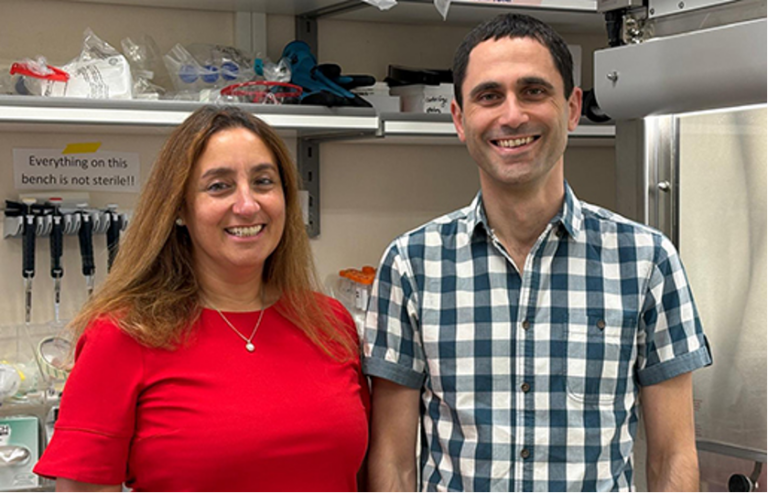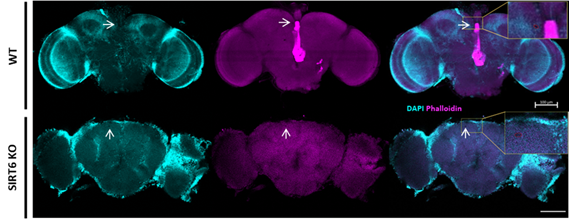Weizmann (Israël) : fonctions cognitives et souffle, il faut respirer avant de passer un examen

[:fr]
Avant de passer un examen, la meilleure chose est de prendre une profonde respiration. Selon les recherches effectuées dans le laboratoire de neurobiologie du Pr Noam Sobel à l’institut Weizmann (Israël), les personnes qui inspirent lorsqu’on leur présente une tâche visuo-spatiale étaient plus aptes à la remplir que celles qui expirent. Cette étude suggère que le système olfactif pourrait avoir façonné l’évolution de la fonction cérébrale bien au-delà de la fonction de base de l’odorat.
Cela pourrait conduire aussi à la recherche de méthodes pour aider les enfants et les adultes présentant des troubles de l’attention et de l’apprentissage à améliorer leurs compétences grâce à une respiration nasale contrôlée.
Le Dr Ofer Perl, qui a dirigé la recherche en tant qu’étudiant diplômé dans le laboratoire du Pr Sobel, explique que l’odorat est le sens le plus ancien : «Même les plantes et les bactéries peuvent sentir les molécules dans leur environnement et réagir. Tous les mammifères terrestres sentent en absorbant de l’air par les voies nasales et en transmettant des signaux par les nerfs au cerveau». Certaines théories suggèrent que ce sens ancien a servi de modèle au développement d’autres parties du cerveau, que chaque sens supplémentaire a évolué à l’aide du modèle précédemment défini. De là est née l’idée qu’inhaler pourrait préparer le cerveau à assimiler de nouvelles informations en synchronisant les deux processus.
Des études menées dans les années 1940 avaient montré que les zones du cerveau impliquées dans le traitement des odeurs – et donc dans l’inhalation – étaient liées à celles qui créaient de nouveaux souvenirs.
Cette nouvelle étude émet l’hypothèse que des parties du cerveau impliquées dans un fonctionnement cognitif supérieur pourraient aussi avoir évolué selon le même modèle de base, même si elles n’ont aucun lien avec l’odorat. «Chez d’autres mammifères, l’odorat, l’inhalation et le traitement de l’information vont de pair. Notre hypothèse affirmait que ce n’était pas seulement le système olfactif, mais tout le cerveau qui se préparait à traiter de nouvelles informations par inhalation. Nous pensons à cela comme à un cerveau renifleur », explique Noam Sobel.
Pour tester leur hypothèse, les chercheurs ont conçu une expérience dans laquelle ils pouvaient mesurer le flux d’air à travers les narines des sujets et, en même temps, leur présenter des problèmes de test à résoudre. Ceux-ci comprenaient des problèmes de mathématiques, des problèmes de visualisation spatiale (décider si un dessin d’une figure tridimensionnelle peut exister dans la réalité) et des tests verbaux (décider si les mots présentés à l’écran sont réels).
Les sujets ont été invités à cliquer sur un bouton, une fois lorsqu’ils ont répondu à une question et une fois lorsqu’ils sont prêts pour la question suivante. Les chercheurs ont noté que lorsque les sujets traversaient les problèmes, ils prenaient l’air juste avant d’appuyer sur le bouton correspondant à la question. L’expérience a été conçue pour que les chercheurs s’assurent que les sujets ne sachent pas que leurs inhalations étaient surveillées, et ils ont exclu un scénario dans lequel le fait d’appuyer sur un bouton était lui-même un motif d’inspiration plutôt que de préparation à la tâche.
Ensuite, les chercheurs ont modifié le format, ne donnant aux sujets que les problèmes d’espace à résoudre, mais la moitié ont été présentés comme les personnes testées inspirées, la moitié lorsqu’elles exhalaient. L’inhalation s’est avérée être liée de manière significative à la réussite des problèmes du test. Au cours de l’expérience, les chercheurs avaient mesuré l’activité électrique cérébrale des sujets à l’aide de l’EEG. Ils ont également constaté des différences entre inhaler et exhaler, notamment en ce qui concerne la connectivité entre différentes parties du cerveau. Cela était vrai aussi bien pendant les périodes de repos que lors de la résolution de problèmes, avec des modèles de connectivité altérés liés à l’inhalation.
En outre, plus l’écart entre les deux niveaux de connectivité est grand, plus l’inhalation semble aider les sujets à résoudre leurs problèmes. «On pourrait penser que le cerveau associe l’inhalation à l’oxygénation et se prépare ainsi à mieux se concentrer sur les questions de test, mais le délai ne convient pas. Cela se produit en moins de 200 millisecondes, bien avant que l’oxygène ne passe des poumons au cerveau. Nos résultats montrent que ce n’est pas seulement le système olfactif qui est sensible à l’inhalation et à l’expiration, c’est tout le cerveau. Nous pensons que nous pourrions généraliser et dire que le cerveau fonctionne mieux avec la respiration », déclare Noam Sobel.
Les résultats pourraient aider, entre autres, à expliquer pourquoi le monde semble flou lorsque nos narines sont bouchées. Le Pr Sobel souligne que le mot inspiration signifie à la fois respirer et mobiliser l’intellect ou les émotions. Et ceux qui pratiquent la méditation savent que la respiration est la clé pour contrôler les émotions et les pensées. Notre sens de l’odorat a, d’une façon ou d’une autre, très probablement fourni le prototype de l’évolution du reste de notre cerveau.
Publication dans Nature Human Behavior, 11 mars 2019
Traduction/adaptation : Israël Science Info
[:en]
A shot of espresso, a piece of chocolate or a headstand – all of these have been recommended before taking a big test. The best advice, however, could be to take a deep breath. According to research conducted in the lab of Prof. Noam Sobel of the Weizmann Institute of Science’s Neurobiology Department, people who inhaled when presented with a visuospatial task were better at completing it than those who exhaled in the same situation. The results of the study, which were published in Nature Human Behavior, suggest that the olfactory system may have shaped the evolution of brain function far beyond the basic function of smelling.
Dr. Ofer Perl, who led the research as a graduate student in Sobel’s lab, explains that smell is the most ancient sense: “Even plants and bacteria can ‘smell’ molecules in their environment and react. But all terrestrial mammals smell by taking air in through their nasal passages and passing signals through nerves into the brain.” Some theories suggest that this ancient sense set the pattern for the development of other parts of the brain. That is, each additional sense evolved using the template that had previously been set out by the earlier ones. From there the idea arose that inhalation, in and of itself, might prepare the brain for taking in new information – in essence, synchronizing the two processes.
Indeed, studies from the 1940s on had found that the areas of the brain that are involved in processing smell – and thus in inhalation – were connected with those that create new memories. But the new study started with the hypothesis that parts of the brain involved in higher cognitive functioning may also have evolved along the same basic template, even if these have no ties whatsoever to the sense of smell. “In other mammals, the sense of smell, inhalation and information processing go together,” says Sobel. “Our hypothesis stated that it is not just the olfactory system, but the entire brain that gets ready for processing new information upon inhalation. We think of this as the ‘sniffing brain’.”
To test their hypothesis, the researchers designed an experiment in which they could measure the air flow through the nostrils of subjects and, at the same time, present them with test problems to solve. These included math problems, spatial visualization problems (in which they had to decide if a drawing of a three-dimensional figure could exist in reality) and verbal tests (in which they had to decide whether the words presented on the screen were real). The subjects were asked to click on a button – once when they had answered a question and once when they were ready for the next question. The researchers noted that as the subjects went through the problems, they took in air just before pressing the button for the question.
The experiment was designed so the researchers could ensure the subjects were not aware that their inhalations were being monitored, and they ruled out a scenario in which the button pushing, itself, was reason for inhaling, rather than preparation for the task.
It is not just the olfactory system, but the entire brain that gets ready for processing new information upon inhalation
Next, the researchers changed the format around, giving subjects only the spatial problems to solve, but half were presented as the test-takers inhaled, half as they exhaled. Inhalation turned out to be significantly tied to successful completion of the test problems. During the experiment, the researchers had measured the subjects’ electric brain activity with EEG, and here too they found differences between inhaling and exhaling, especially in connectivity between different parts of the brain. This was true during rest periods as well as in problem-solving, with altered connectivty patterns linked to inhaling. Moreover, the larger the gap between the two levels of connectivity, the more inhaling appeared to help the subjects solve problems.
“One might think that the brain associates inhaling with oxygenation and thus prepares itself to better focus on test questions, but the time frame does not fit,” says Sobel. “It happens within 200 milliseconds – long before oxygen gets from the lungs to the brain. Our results show that it is not only the olfactory system that is sensitive to inhalation and exhalation – it is the entire brain. We think that we could generalize and say that the brain works better with inhalation.”
The findings could help explain, among other things, why the world seems fuzzy when our noses are stuffed. Sobel points out that the very word “inspiration” means both to breathe in and to move the intellect or emotions. And those who practice meditation know that the breath is key to controlling emotions and thoughts. This, though, is important empirical support for these intuitions, and it shows that our sense of smell, in some way, most likely provided the prototype for the evolution of the rest of our brain.
The scientists think their findings may, among other things, lead to research into methods to help children and adults with attention and learning disorders improve their skills through controlled nasal breathing.
Publication in Nature Human Behavior March 11th 2019
[:]







